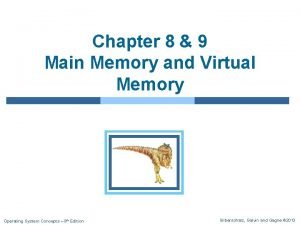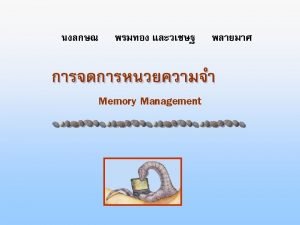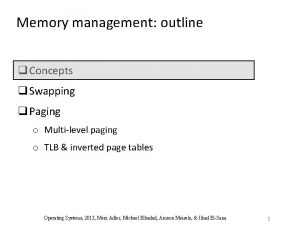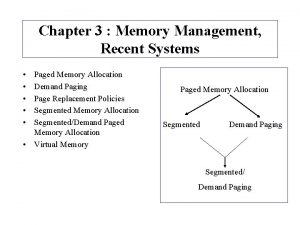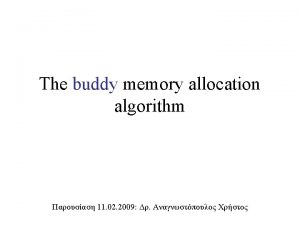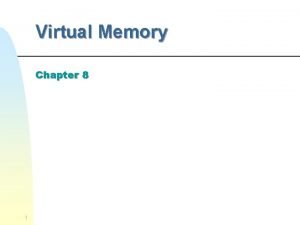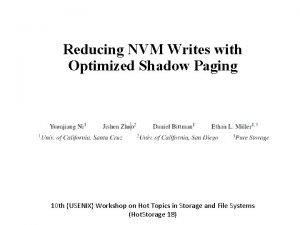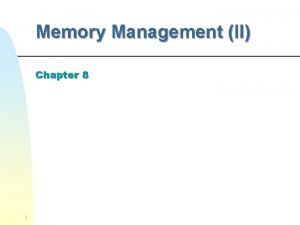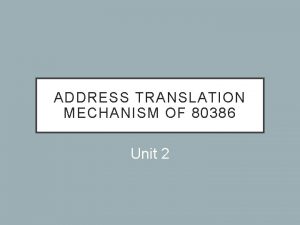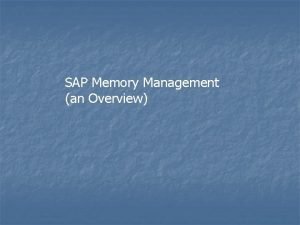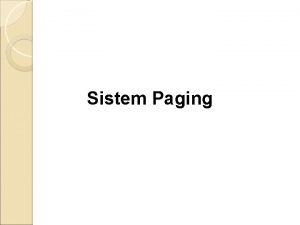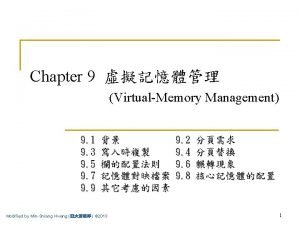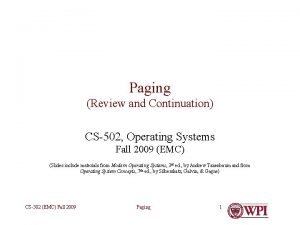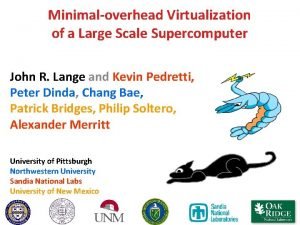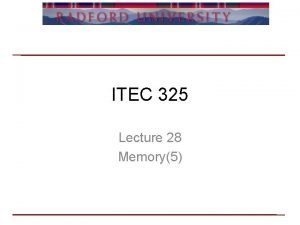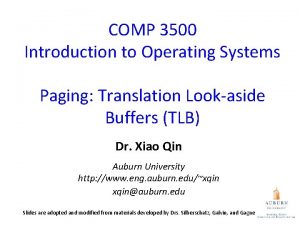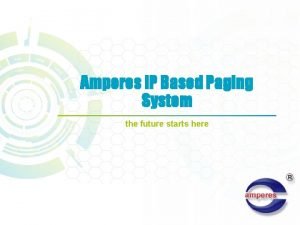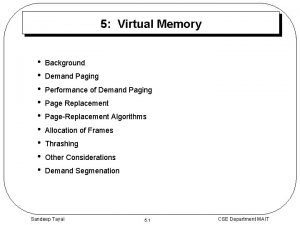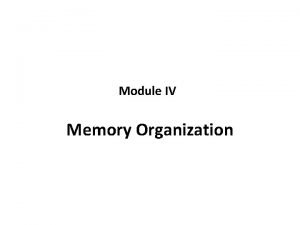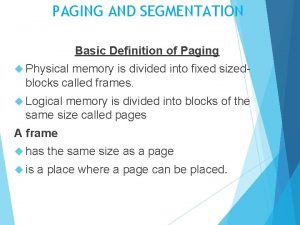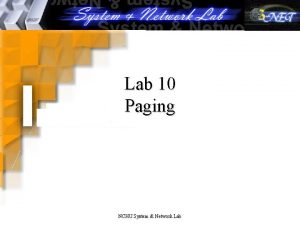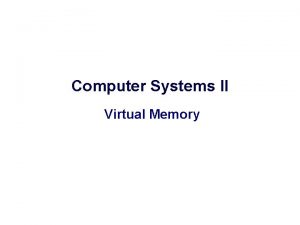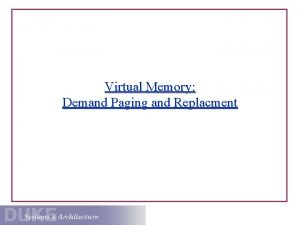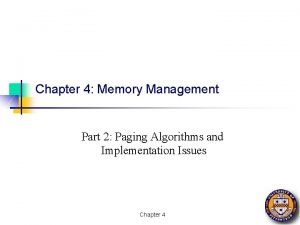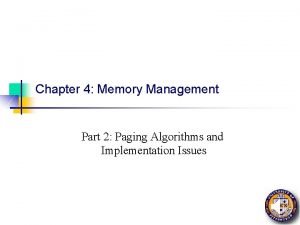Memory Management II Chapter 8 1 Paging Implementation






























- Slides: 30

Memory Management (II) Chapter 8 1

Paging Implementation Typically, each process has its own page table n n 2 Each page table entry contains a present bit to indicate whether the page is in main memory or not. u If it is in main memory, the entry contains the frame number of the corresponding page in main memory u If it is not in main memory, the entry may contain the address of that page on disk or the page number may be used to index another table (often in the PCB) to obtain the address of that page on disk

Paging Implementation n n 3 A modified bit indicates if the page has been altered since it was last loaded into main memory u If no change has been made, the page does not have to be written to the disk when it needs to be swapped out Other control bits may be present if protection is managed at the page level u a read-only/read-write bit u protection level bit: kernel page or user page (more bits are used when the processor supports more than 2 protection levels)

Page Table Structure n In the simplest case, the page table is implemented as a set of dedicated registers u n Page tables are large and of variable length, depending on the process size u n 4 This is satisfactory only if the page table size is small Page table is kept in main memory instead of registers A single register holds the starting physical address of the page table of the currently running process

Address Translation in a Paging System 5

Sharing Pages n n 6 If we share the same code among different users, it is sufficient to keep only one copy in main memory Shared code must be reentrant (ie: non selfmodifying) so that 2 or more processes can execute the same code If we use paging, each sharing process will have a page table whose entry points to the same shared frames: only one copy is kept in main memory Each user, however, needs to have its own private data pages

Sharing Pages: a text editor 7

Translation Look-aside Buffer n Because the page table is in main memory, each virtual memory reference causes at least two physical memory accesses u one to fetch the page table entry u one to fetch the data n To overcome this problem a special cache, Translation Look-aside Buffer, is set up for page table entries u. A set of associative registers u Contains page table entries that have been most recently used u Similar to main memory cache 8

Translation Look-aside Buffer n Given a logical address, the processor examines the TLB u n n All entries of the associative registers are examined simultaneously If page table entry is present (a hit), the frame number is retrieved and the real (physical) address is formed If page table entry is not found in the TLB (a miss), the page number is used to index the process page table if present bit is set then the corresponding frame is accessed u if not, a page fault is issued to bring in the referenced page in main memory u 9 n The TLB is updated to include the new page entry

Use of a Translation Lookaside Buffer 10

TLB Characteristics n n n TLB use associative mapping hardware to simultaneously interrogates all TLB entries to find a match on page number The TLB must be flushed each time a new process enters the Running state The CPU uses two levels of cache on each virtual memory reference u first the TLB: to convert the logical address to the physical address u once the physical address is formed, the CPU then looks in the cache for the referenced word 11

Multilevel Paging n n 12 Most computer systems support a very large virtual address space u 32 to 64 bits are used for logical addresses u If (only) 32 bits are used with 4 KB pages, a page table may have 2^{20} entries The entire page table may take up too much main memory. Hence, page tables are often stored in virtual memory and subjected to paging u When a process is running, part of its page table must be in main memory (including the page table entry of the currently executing page)

Multilevel Page Tables n Since a page table will generally require several pages to be stored. One solution is to organize page tables into a multilevel hierarchy u When 2 levels are used (ex: 386, Pentium), the page number u 13 is split into two numbers p 1 and p 2 p 1 indexes the outer paged table (directory) in main memory whose entries points to a page containing page table entries which is itself indexed by p 2. Page tables, other than the directory, are swapped in and out as needed

Inverted Page Table n n n Another solution (Power. PC, IBM Risk 6000) to the problem of maintaining large page tables is to use an Inverted Page Table (IPT) We generally have only one IPT for the whole system There is only one IPT entry per physical frame (rather than one per virtual page) u n The 1 st entry of the IPT is for frame #1. . . the nth entry of the IPT is for frame #n and each of these entries contains the virtual page number u 14 this reduces the amount of memory needed for page tables Thus this table is inverted

Inverted Page Table n n The process ID with the virtual page number could be used to search the IPT to obtain the frame # For better performance, hashing is used to obtain a hash table entry which points to a IPT entry u. A page fault occurs if no match is found u chaining is used to manage hashing overflow 15

Segmentation Typically, each process has its own segment table n n n 16 Similarly to paging, each segment table entry contains a present bit and a modified bit If the segment is in main memory, the entry contains the starting address and the length of that segment Other control bits may be present if protection and sharing is managed at the segment level Logical to physical address translation is similar to paging except that the offset is added to the starting address (instead of being appended)

Address Translation in a Segmentation System 17

Segmentation: comments n n 18 Each segment table entry contains both the starting address and length of the segment u the segment can thus dynamically grow or shrink as needed u address validity easily checked with the length field But variable length segments introduce external fragmentation and are more difficult to swap in and out. . . It is natural to provide protection and sharing at the segment level since segments are visible to the programmer (pages are not) Useful protection bits in segment table entry: u read-only/read-write bit u Supervisor/User bit

Sharing in Segmentation Systems n n Segments are shared when entries in the segment tables of 2 different processes point to the same physical locations Ex: the same code of a text editor can be shared by many users u Only n 19 one copy is kept in main memory Each user stills need to have their own private data segment

Sharing of Segments: text editor example 20

Combined Segmentation and Paging n n 21 To combine their advantages some processors and OS page the segments. Several combinations exists. In a simple scheme, each process has: u one segment table u several page tables: one page table per segment The virtual address consist of: u a segment number: used to index the segment table whose entry gives the starting address of the page table for that segment u a page number: used to index that page table to obtain the corresponding frame number u an offset: used to locate the word within the frame

Address Translation in a (simple) combined Segmentation/Paging System 22

Simple Combined Segmentation and Paging n n n 23 The Segment Base is the physical address of the page table of that segment Present and modified bits are present only in page table entry Protection and sharing information most naturally resides in the segment table entry u Ex: a read-only/read-write bit, a kernel/user bit. . .

Windows NT Virtual Memory n n 24 Uses paging only (no segmentation) with a 4 KB page size Each process has 2 levels of page tables: u a page directory containing 1024 page-directory entries (PDEs) of 4 bytes each u each page-directory entry points to a page table that contains 1024 page-table entries (PTEs) of 4 bytes each u so we have 4 MB of page tables per process u the page directory is in main memory but page tables containing PTEs are swapped in and out as needed

Windows NT Virtual Memory n n n 25 Virtual addresses (p 1, p 2, d) use 32 bits where p 1 and p 2 are each 10 bits wide u p 1 selects an entry in the page directory which points to a page table u p 2 selects an entry in this page table which points to the selected page Upon creation, NT commits only a certain number of virtual pages to a process and reserves a certain number of other pages for future needs Hence, a group of bits in each PTE indicates if the corresponding page is committed, reserved or not used

Windows NT Virtual Memory n n 26 A memory reference to an unused page traps into the OS (protection violation) Each PTE also contains: u a present bit F If set: 20 bits are used for the frame address of the selected page. F Else these bits are used to locate the selected page in a paging file (on disk) u some bits identify the paging file used u a dirty bit (i. e. , : a modified bit) u some protection bits (ex: read-only, or read-write)

Intel 386 segmentation and paging n n n In protected mode, the 386 (and up) uses a combined segmentation and paging scheme which is exploited by OS/2 (32 -Bit version) The logical address is a pair (selector, offset) The selector contains a bit which selects either: the Global Descriptor Table; accessible by all processes u the Local Descriptor Table; accessible only by the process who owns it (we have one LDT per process) u n 27 Two bits in the selector are for protection and the remaining 13 bits are use to select an 8 -byte entry either in the LDT or the GDT called a descriptor

Intel 386 segmentation and paging n The 386 has 6 segment registers each having a 16 bit visible part that holds a selector and a 8 -byte invisible part that contain the corresponding descriptor u n n The descriptor contains the base address and the length of the referenced segment The 32 -bit base address is added to the 32 -bit offset to forme a 32 -bit linear address (p 1, p 2, d) which is basically identical to the logical address format used by Windows NT u 28 this avoids having to read the LDT/GDT at each memory reference 2 levels of page tables indexed by p 1 and p 2 (10 bits each)

Intel 386 address translati on 29

386 Segmentation and Paging n n n The segmentation part can be effectively disabled by clearing the base address of each segment descriptor Then the offset part of the logical address is identical to the linear address (p 1, p 2, d) This is used by every OS that runs on 386 (and up) and uses only paging: u Windows NT u Unix versions: Linux, Free. BSD. . . 30
 What is virtual memory
What is virtual memory Virtual memory in os
Virtual memory in os Paged segmentation
Paged segmentation Demand paging in virtual memory
Demand paging in virtual memory Virtual memory demand paging
Virtual memory demand paging Q concepts
Q concepts Segmented/demand paged memory allocation
Segmented/demand paged memory allocation Buddy memory allocation implementation
Buddy memory allocation implementation System 1 evolution
System 1 evolution What are the characteristics of paging ?
What are the characteristics of paging ? Shadow paging
Shadow paging Multilevel paging in os
Multilevel paging in os Contoh paging
Contoh paging Paging in lte
Paging in lte Combined segmentation and paging
Combined segmentation and paging The logical address of intel 80386 is
The logical address of intel 80386 is Umhs paging
Umhs paging Paging simulation
Paging simulation Sap paging
Sap paging Komponen sistem paging
Komponen sistem paging Demand paging
Demand paging Paging mechanism in 80386
Paging mechanism in 80386 Paging system design
Paging system design Paging
Paging Pong paging
Pong paging Tlb paging
Tlb paging Comp3500
Comp3500 Tlb paging
Tlb paging Shadow paging recovery technique
Shadow paging recovery technique Ip based paging system
Ip based paging system Performance of demand paging
Performance of demand paging



